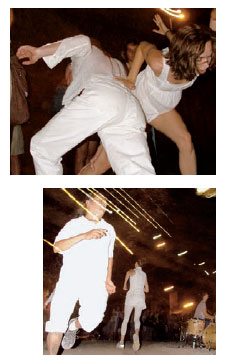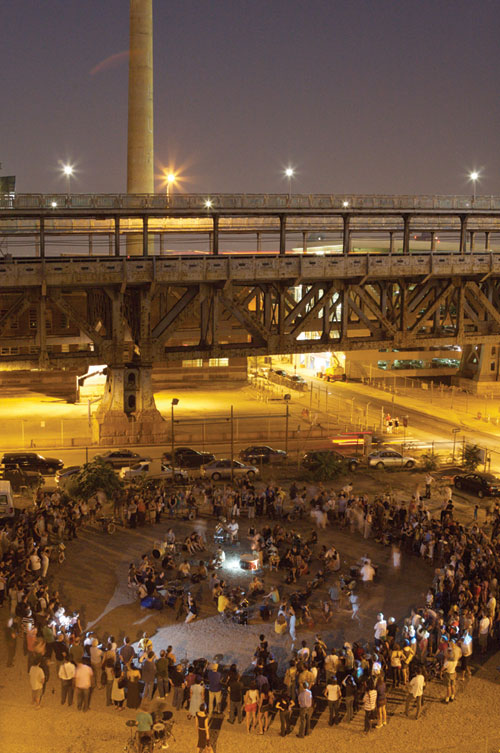Gallery: Principles of uncertainty
Dance of the particles
In an empty urban lot beneath an overpass in Philadelphia, drummers beat a slow and steady rhythm. Two groups of dancers circle them in opposite directions. The drums pick up speed, pounding louder, the spaces between the beats filling with the clash of cymbals and a complex clatter of superimposed rhythms. The dancers steps quicken. They race around the circle, faster, faster. Wham! They collide, spinning off in various directions.
Far from accidental, the choreographed collisions tell the story of science at Fermilab.
Members of Philadelphia-based Miro Dance Theatre and collaborators Nadia Hironaka and Eugene Lew conceived, choreographed, and produced the work, Principles of Uncertainty, to show the intricate beauty of a subatomic particle collision and its aftermath. They were fascinated by the science and its parity with social life.
Human elements collide every day, from different cultures, traditions, and backgrounds, and from these collisions new and unpredictable elements or relationships are produced, says Tobin Rothlein, producing artistic director for Miro, who is a dance, video and performance artist.
 |
Choreographer Amanda Miller, Miro artistic director, based the dance moves on a system of structured improvisation that involved physics concepts such as velocity, trajectory, and symmetry.
We felt this structure reflected the ever-shifting random variants of particle physics, and the freedom that exists within any set of rules, Miller says.
The group bulked up its science knowledge with a trip to Fermilab, the countrys premier particle physics laboratory. They met with experimenters, theorists, and educators. As they learned more about physics and about accelerator science in particular, sketches of trajectories and choreography filled the pages of their notebooks.
In the end, each person represented one piece of the accelerator puzzle. The audience, numbering in the hundreds for each of three performances on Sept. 7, 2007, served as the detector. The drums played the part of an accelerator, the dancers were particles, and a backdrop of projected videos became a visual interpretation of monitors in Fermilabs control rooms.
The physics allusions began even before the performance started: Dancers waited in a holding chamber that represented a pre-accelerator. Once they were let into the ring, their movements reflected a detailed symbolic choreography.
The dancers speeding one direction were supposed to represent positively charged particles, and those spinning the opposite direction, the negatively charged particles, says Hironaka, who is a video artist.
The Miro Dance Theatre artists will continue their interpretation of particle physics with a new stage show, Spooky Action, commissioned by Indiana University of Pennsylvania Lively Arts. Set to premiere in April of 2009, this spin-off production will explore love and quantum entanglement. Miro will continue to use Fermilab as a resource, and will be working with students and community members, trying to interest them in both science and the arts. Principles of Uncertainty is now available for touring, with the idea of altering the work for each specific location.
Were treating this like an experiment, Hironaka says.
 |
Text by Rhianna Wisniewski
Photos by Blaine Siegel and Aaron Igler
Click here to download the pdf version of this article.






